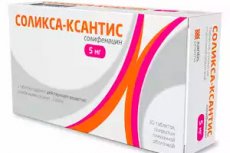新出版物
索利克萨-桑提斯
阿列克谢·克里文科,医学审稿人
最近審查:04.07.2025
最近審查:04.07.2025

Solixa-Xanthis(索利那新)是一种用于治疗膀胱过度活动症 (OAB) 症状的药物。OAB 的特征包括尿频、突然强烈尿意(尿急)以及尿急导致的尿失禁等症状。
索利那新是一种抗毒蕈碱(抗胆碱能)药物,通过阻断膀胱中的毒蕈碱受体起作用。这会导致膀胱逼尿肌松弛,降低膀胱收缩的频率和强度,并改善排尿控制能力。
適應症 索利克萨-桑提斯
- 尿频:白天和夜间排尿频率增加(尿频)。
- 尿急:突然而强烈的尿意,难以控制。
- 急迫性尿失禁:由于迫切需要排尿而导致尿液不自主流出。
發布表單
片剂:Solixa-Xantis 为口服片剂,通常含有 5 毫克和 10 毫克琥珀酸索利那新。
藥效學
- 毒蕈碱受体拮抗作用:索利那新阻断膀胱等各种器官和组织中的毒蕈碱乙酰胆碱受体,导致胆碱能系统活性降低。
- 膀胱收缩减少:用索利那新阻断膀胱中的毒蕈碱受体可减少自发性膀胱收缩并增加膀胱容量,这可能有助于减少排尿的频率和力度。
- 改善尿失禁症状:使用索利那新可以帮助减轻尿失禁症状,例如频繁、不自主或感觉需要经常上厕所。
- 改善膀胱功能:阻断毒蕈碱受体也可能改善膀胱过度活动症患者的膀胱功能,帮助他们更好地控制排尿功能。
- 减轻平滑肌痉挛:索利那新还可能对膀胱平滑肌产生解痉作用,有助于放松膀胱并减轻痉挛。
藥代動力學
吸收:
- 口服后,索利那新在胃肠道吸收良好。
- 给药后约3-8小时达到血浆最大浓度。
- 生物利用度约为90%。
分配:
- 索利那新的分布容积约为600升。
- 该药物与血浆蛋白结合率为98%,主要与白蛋白和酸性α1-糖蛋白结合。
代谢:
- 索利那新在肝脏中在酶 CYP3A4 的参与下被广泛代谢。
- 主要代谢物包括4R-羟基化化合物和N-葡萄糖醛酸化化合物。
排泄:
- 索利那新的半衰期约为45-68小时。
- 约70%的给药剂量通过尿液排出,其中约11%以未改变的药物形式排出,18%以N-葡萄糖醛酸代谢物形式排出。
- 约23%的剂量通过粪便排出。
特殊人群:
- 在老年患者以及肝功能或肾功能受损的患者中,索利那新的药代动力学可能会发生改变,这可能需要调整剂量。
劑量和管理
建议剂量:
初始剂量:
- 一般建议以每天一次 5 毫克的剂量开始。
维持剂量:
- 如果有必要并且药物耐受性良好,剂量可以增加到每天一次 10 毫克。
使用方法:
- 用足量的水口服药片。
- 服用时间:无论是否进食都可以服用药片。
- 频率:每天服用一次药物,最好每天在同一时间服用,以维持体内药物的稳定水平。
特别说明:
- 漏服剂量:如果您漏服了一剂,请尽快服用。如果快到下次服药时间了,请勿服用双倍剂量来弥补漏服的剂量。只需继续正常服用即可。
- 过量服用:如果过量服用,请立即就医。
在懷孕期間使用 索利克萨-桑提斯
不建议在怀孕期间使用Solix-Xantis,因为目前尚无令人信服的数据证明其对胎儿的安全性。以下是现有研究的要点:
- 索利那新与口服避孕药的药代动力学相互作用研究表明,索利那新不影响炔雌醇和左炔诺孕酮的药代动力学,这可能与索利那新在育龄妇女中的使用有关。然而,该研究并未探讨索利那新在妊娠期使用的安全性(Taekema-Roelvink 等人,2005)。
- 一项关于女性排尿后滴沥的有效性和安全性的研究发现,索利那新与安慰剂之间无显著差异。该研究未纳入特定的孕妇群体,因此索利那新在妊娠期的安全性数据仍然有限(Ablove 等人,2018)。
由于缺乏有关怀孕期间使用索利那新的安全性的数据,因此在使用前咨询医生以评估对发育中胎儿的所有潜在风险非常重要。
禁忌
- 超敏反应:已知对索利那新或该药物的任何其他成分有超敏反应或过敏反应的人应避免使用本品。
- 严重肾功能不全:不建议严重肾功能不全(肌酐清除率<30 ml/min)患者使用该药物,尤其是当他们正在接受强效 CYP3A4 抑制剂(例如酮康唑)治疗时。
- 严重肝功能不全:严重肝功能不全(Child-Pugh C 级)患者禁用索利那新。
- 闭角型青光眼:由于存在眼压升高的风险,不建议未控制的闭角型青光眼患者使用该药物。
- 重症肌无力:索利那新可能会加重重症肌无力的症状,因此禁用于此种疾病。
- 急性尿潴留:该药禁用于急性尿潴留患者,因为它可能会使病情恶化。
- 胃肠道阻塞:该药禁用于胃肠道阻塞患者,包括中毒性巨结肠和麻痹性肠梗阻。
- 严重胃轻瘫:严重胃轻瘫(胃排空延迟)患者不应使用该药物。
副作用 索利克萨-桑提斯
非常常见的副作用(超过 10%):
- 口干。
常见副作用(1-10%):
- 便秘。
- 恶心。
- 消化不良。
- 腹痛。
- 眼睛干涩。
- 视力模糊。
- 心跳加速(心动过速)。
- 疲劳。
不常见的副作用(0.1-1%):
- 泌尿道感染。
- 排尿困难(例如尿潴留)。
- 尿潴留。
- 皮肤干燥。
- 感觉口渴。
- 视觉障碍,包括视力模糊。
- 睡意。
- 头晕。
- 鼻窦炎。
罕见副作用(0.01-0.1%):
- 过敏反应。
- 皮疹或瘙痒等过敏反应。
- 血管性水肿。
- 意识混乱。
- 幻觉。
- 心律紊乱(例如QT间期延长、心律失常)。
非常罕见的副作用(少于0.01%):
- 精神疾病(例如焦虑、抑郁)。
- 抽筋。
- 青光眼症状恶化。
過量
- 抗胆碱作用:如口干、便秘、尿潴留、瞳孔散大、皮肤干燥发红、心动过速、心率加快。
- 中枢效应:头痛、头晕、激动、意识模糊、幻觉、嗜睡。
- 严重并发症:严重过量服用可能导致癫痫、昏迷、呼吸抑制和心血管并发症。
过量用药的治疗
索利那新过量治疗通常旨在缓解症状和支持重要功能:
- 活性炭:服用活性炭可能有助于减少服药后短时间内胃肠道对药物的吸收。
- 洗胃:如果最近服用了大量药物,洗胃可能会有帮助。
- 对症治疗:支持呼吸和心血管功能。这可能包括静脉输液、维持血压和心脏监测。
- 解毒剂:在抗胆碱症状严重的情况下,可以在医生的监督下开出毒扁豆碱。
- 住院:在严重的情况下,可能需要住院进行密切监测和治疗。
與其他藥物的相互作用
- CYP3A4 抑制剂:抑制 CYP3A4 酶的药物(例如酮康唑、伊曲康唑、利托那韦、克拉霉素)可能会增加索利那新的血液浓度,从而增加其副作用。
- CYP3A4 诱导剂:诱导 CYP3A4 酶的药物(例如利福平、苯妥英、卡马西平)可能会降低索利那新的血液浓度,从而降低其有效性。
- 抗胆碱药物:与其他抗胆碱药物(例如阿托品、东莨菪碱、某些抗抑郁药和抗精神病药)同时使用可能会增加抗胆碱副作用,如口干、便秘、视力模糊和排尿困难。
- 延长 QT 间期的药物:与延长 QT 间期的药物(例如 IA 类和 III 类抗心律失常药物、某些抗抑郁药和抗精神病药)共同给药可能会增加心律失常的风险。
- 改变胃肠动力的药物:改变胃肠动力的药物(例如甲氧氯普胺)可能会影响索利那新的吸收。
- 抗组胺药:某些抗组胺药可能会增强索利那新的抗胆碱能作用。
- 改变胃液 pH 值的药物:抗酸剂和其他改变胃液 pH 值的药物可能会干扰索利那新的吸收。
注意!
為了簡化對信息的理解,本指令使用了藥物 "索利克萨-桑提斯",並根據藥物的醫療用途官方說明。 使用前請閱讀直接用於藥物的註釋。
描述僅供參考,不適用於自我修復指導。 這種藥物的需求,治療方案的目的,藥物的方法和劑量僅由主治醫師確定。 自我藥療對你的健康有危害。

